How much sexual violence is there in mainstream movies?
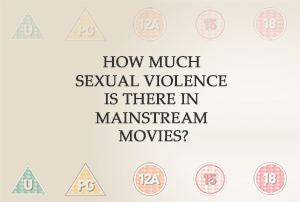
Last week, the UK's film censorship body, the British Board of Film Classification (BBFC), announced new rules on the depiction of sexual violence on screen.
The BBFC's certification guidelines are updated every five years after extensive public consultation. Their most recent study highlighted the public's worries about seeing sexual violence on the big screen and the "pornification" of modern movies.
The example cited in most of the press was The Duchess, a film which is currently a 12A but which could be upped to a 15 if it were ever re-certified under the new guidelines. This led me to wonder: how many other films would be affected by the change?
To answer the question and to look into levels of sexual violence on the big screen, I turned to the data.
Warning: It's worth noting that I'm going to talk in this article about sexual assault, sexual violence and rape in movies. I will do so as sensitively as possible, but if this is a topic you are uncomfortable with then this may be an article to skip.
How are movies regulated in the UK?
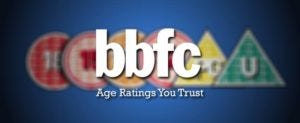
The short answer is that the BBFC awards each movie a certificate. The slightly longer answer is that the legal responsibility for movie regulation actually falls to the local councils who in turn almost always follow the advice of the BBFC. The BBFC is a private body but effectively acts as a quasi-public body, with high levels of public engagement, education and transparency.
Anyone can submit their movie, pay the fee (currently £1,002 plus VAT for a two-hour movie) and within a couple of weeks, you will be awarded one of six certificates:
U – Universal. Suitable for all
PG –Parental Guidance. General viewing, but some scenes may be unsuitable for young children
12A – Suitable for 12 years and over. No one younger than 12 may see a 12A film in a cinema unless accompanied by an adult. This article is focusing on theatrical movies (i.e. in cinemas) but it's worth noting that the equivalent rating for videos and VOD releases is simply "12". The reason for this mismatch is that the BBFC can change their theatrical certificates as they see fit but their video regulations are controlled by an Act of Parliment and so when they introduced the "12A" rating in 2002, the "12" remained for video works.
15 – Suitable only for 15 years and over. No one younger than 15 may see a 15 film in a cinema.
18 – Suitable only for adults. No one younger than 18 may see an 18 film in a cinema.
R18 – To be shown only in specially licensed cinemas, or supplied only in licensed sex shops, and to adults only. I'm not going to address R18 movies in this article as they are not within my focus of "mainstream" movies.
The 15 certificate is the most commonly awarded, although the 12A certificate has been fast closing the gap due to its increased commercial possibilities (i.e. studios don't want to miss out on box office income from young teenagers).
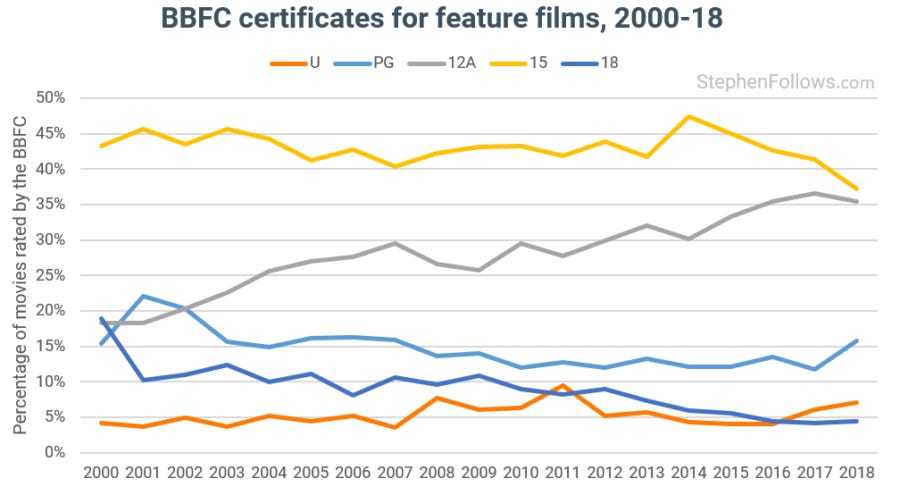
What are the reasons behind the certificates?

For each movie they rate, the BBFC provides a short summary of the movie's sensitive material, entitled 'BBFC Insight'. In most cases, there is both a short-form Insight which is shown next to the certificate on marketing materials and ahead of the movie, and a longer breakdown on the BBFC website.
For example, for Avengers: Infinity War the short-form guidance says just "Moderate violence, threat" whereas the longer guidance says:
There are frequent scenes of moderate fantasy violence in which various characters with special powers fight each other or battle an army of aliens. The violence includes use of shooting with futuristic weapons, punches, kicks and blows from other weaponry. There is a scene in which a character is suspended by wires and pulled apart by a villain trying to extract information from her, but the torture is fantastical. There is a middle finger gesture and incomplete uses of 'mother--' and "chill the f-- out". There are also milder terms such as 'God', 'douche', 'shit', 'crap', 'butt', 'bastards', 'jerk', 'hell', 'ass', 'damn', 'piss' and 'screw'.
I took a look at what were the most frequently mentioned areas of concern in BBFC Insight guidance.
Across all movies, bad language is the most commonly mentioned, with 55.9% of BBFC guidance citing it as a contributing factor to the certificate awarded. 45.9% mentioned violence, 35.2% mentioned something sexual, 11.7% mentioned drugs, 10.0% referred to threat and 4.4% mentioned nudity.
Unsurprisingly, when we split the data by the certificate awarded, we see big differences. Bad language comes out top for U, PG and 15 rated movies but it's trumped by violence among 12A and 18 rated movies.
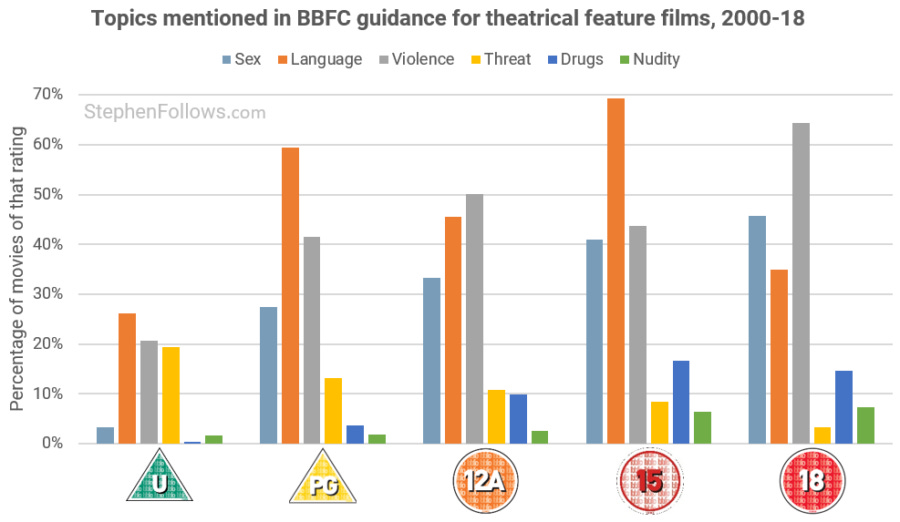
My category of "sex" used above is pretty broad, hence why there are some U rated movies showing up with "sex" Insight guidance. This includes "sex references" such as those in Flushed Away (rated U), Nanny McPhee (U) and Mamma Mia: Here We Go Again (PG).
So if we are to zero in on the films containing sexual violence, we need to be more specific.
How many movies feature sexual violence?
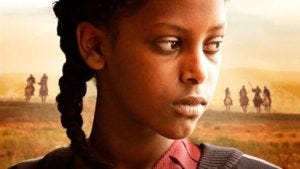
In order to find the target films for today's research, I identified all of those whose BBFC Insight guidance included mentions of sexual abuse, sexual violence, sexual assault and rape.
I split the sexual violence mentions into two categories:
References to sexual violence. These are conversations about the topic, often in the form of verbal or implied threats of sexual violence. I counted phrases such as "implied rape", "implied sexual violence" or "sexual threat" as references, rather than acts, as they must have happened off-camera or otherwise they would have been described with the language of an act.
Acts of sexual violence. I did not distinguish between an attempt or the actual act as that's a distinction without a difference. The issue at hand is not the success of the aggressor but rather the depiction of their attempt.
I do not wish to downplay the disturbing nature of references to sexual violence. Films can contain only verbal mentions of sexual violence but still be hard to watch. For example, Difret is a 12A rated Ethiopian drama about a female lawyer's defence of a 14-year-old girl who was abducted and raped by a neighbouring tribesman. Other films, such as the The Club (18) contain "Very strong verbal references to child sexual abuse" according to the BBFC guidance.
Looking at the data for sexual violence in movies, we find:
No U-rated movies featured anything related to sexual violence.
Three PG-rated films carried warnings, all of which were references. They were Maylam comedy Punyalan Private Limited (BBFC's guidance was "references to sexual violence, mild bad language"), American music documentary The I Heart Revolution ("references to sexual abuse and child prostitution") and Bollywood drama Yeh Zindagi Ka Safar ("infrequent mild language, violence and sexual assault references"). There were no acts of sexual violence in any of these films.
Only 1.3% of 12A-rated films had either references or acts. References were much more common among 12A films, with 71.8% of mentions of sexual violence relating to references, with only 28.2% relating to acts.
3.3% of all 15-rated films had guidance relating to sexual violence, with the vast majority describing acts.
One in ten 18-rated films contained acts of sexual violence, as well as a further 1% which featured references.
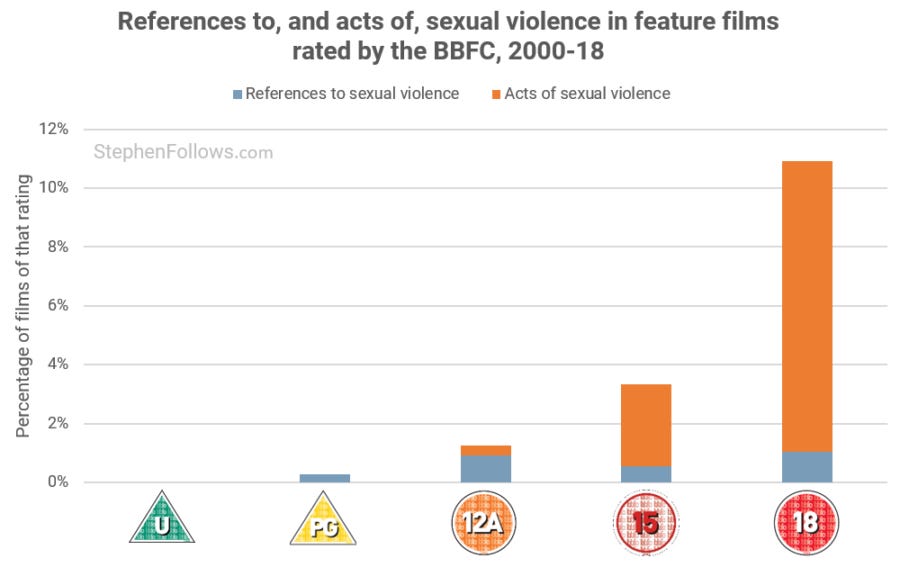
This article was sparked by the BBFC's decision to be tougher on "depictions of sexual violence". This has been widely reported as mostly meaning films which previously would have received a 12A and will in future receive a 15 or 18 certificate. Therefore, the following films appear to be good examples of the effect of this change (i.e. all 12As which feature acts of sexual violence):
Moulin Rouge (2001) - Moderate language, sex references and a scene of attempted rape.
Koi Aap Sa (2005) - Moderate sexual assault.
Mayakkanadi (2006) - One instance of humiliation violence and mild sexual violence.
The World Unseen (2007) - Moderate violence and brief sexual violence.
The Duchess (2008) - Sexual violence, moderate sex.
Janakan (2010) - Moderate violence and one scene of sexual violence.
Belle (2013) - Brief sexual assault, discrimination theme.
Tin (2014) - Sexual assault, moderate injury detail.
RSC Live From Stratford Upon Avon: The Two Gentlemen Of Verona (2014) - Attempted sexual assault, hard drug references.
Paisa Vasool (2017) - Infrequent strong language, moderate bloody violence, brief sexual violence.
Kavan (2017) - Moderate violence, sexual violence, moderate bad language.
Notes

Today's piece focuses on feature films, meaning that "Straight to DVD" or VOD-only products were excluded. The data came from the BBFC's comprehensive website. On the website, they lay out all their decisions and the rationale behind them, as well as providing information about ratings more generally and an interesting podcast.
For ease, I have combined the 12 and 12A certificate in the charts. The 12A certificate was introduced in 2002 and some of the early films in the charts will have been a 12 for their theatrical release.
The BBFC's updated guidelines are also going to be tougher on what the BBFC refer to as "very strong sex references". I only found nine feature films since 2000 which have received this language from the BBFC, all rated 18. It's not clear if this means that they will be harsher on these types of films (therefore demanding harsher cuts to those scenes), or if they will start assigning the "very strong sex" label to milder scenes of sex than they currently do.
Epilogue
This is a tough topic to cover. From a data point of view, I want to be as detailed and thorough as possible, whereas from a human point of view I want to be sensitive to the many people for whom this is a troubling topic. I hope I have navigated it correctly. If you feel otherwise, please do drop me a line with any concerns and I'll make amends where appropriate.
This change in BBFC policy is a great example of a measured approach to censorship. It is based on a large-scale, open review process which engaged over 10,000 members of the public. The BBFC conducts such reviews every five years to ensure they don't lose sync with public attitudes. This ensures that they are striking the right balance between protecting the vulnerable and getting out of the way of artists to express their visions.


